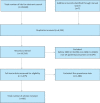Prevalence of use of complementary and alternative medicine (CAM) by patients/consumers in the UK: systematic review of surveys
- PMID: 23681857
- PMCID: PMC4952625
- DOI: 10.7861/clinmedicine.13-2-126
Prevalence of use of complementary and alternative medicine (CAM) by patients/consumers in the UK: systematic review of surveys
Abstract
This systematic review aimed to estimate the prevalence of use of complementary and alternative medicine (CAM) in the UK. Five databases were searched for English language, peer-reviewed surveys published between 1 January 2000 and 7 October 2011. In addition, relevant book chapters and files from our own departmental records were searched by hand. Eighty-nine surveys were included, with a total of 97,222 participants. Most studies were of poor methodological quality. Across surveys on CAM in general, the average one-year prevalence of use of CAM was 41.1% and the average lifetime prevalence was 51.8%. In methodologically sound surveys, the equivalent rates were 26.3% and 44%, respectively. In surveys with response rates >70%, average one-year prevalence was nearly threefold lower than in surveys with response rates between 21% and 50%. Herbal medicine was the most popular CAM, followed by homeopathy, aromatherapy, massage and reflexology. Many patients and consumers in the UK use CAM; healthcare professionals should therefore responsibly advise their patients about the use of CAM.
Keywords: complementary and alternative medicine; survey; systematic review.
Figures
References
-
- Ernst E, Pittler MH, Wider B, Boddy K. The desktop guide to complementary and alternative medicine, 2nd edition Edinburgh: Elsevier Mosby, 2006.
-
- Ernst E, White AR. The BBC survey of complementary medicine use in the UK. Complement Ther Med 2000; 8: 32–36. - PubMed
-
- Singh S. The hidden risks of alternative medicine. Focus Alt Complement Ther 2009; 14: 175–6. 10.1211/fact.14.3.0005 - DOI
-
- Hunt K, Ernst E. Patients' use of CAM: results from the Health Survey for England 2005. Focus Alt Complement Ther 2010; 15: 101–3.
-
- Anon A. Taking an alternative route to good health. Which? 2006; Feb: 10–5.
Publication types
MeSH terms
LinkOut - more resources
Full Text Sources
Other Literature Sources
Medical


